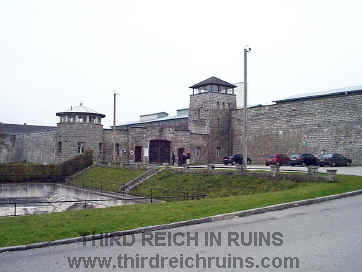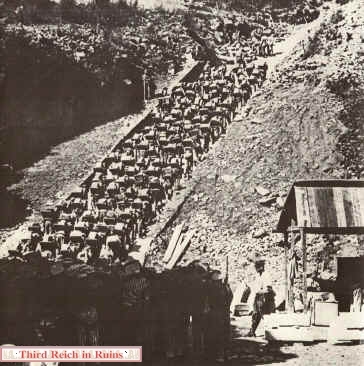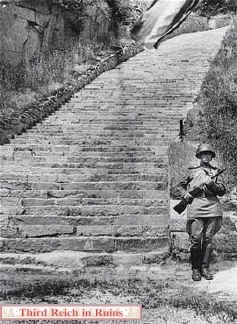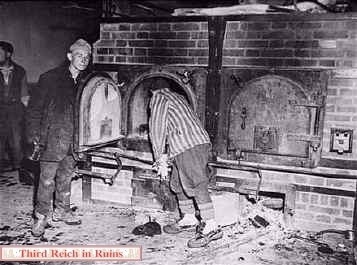|
Mauthausen Concentration
Camp
Following the Anschluss (union) with
Austria in March 1938, the Nazis immediately began construction of a concentration camp
near Linz. The site was designed to resemble an old fortress, complete
with stone guard towers. Jews and political prisoners from Austria, Holland, Italy, and
Hungary were forced into labor at the huge granite quarry on the site. During the war,
thousands of Russian and Polish POWs were also interned at Mauthausen.
Mauthausen held the record for concentration
camps (as opposed to extermination camps) for executions and deaths, some 36,000 from
January 1939 through April 1945. Many of these died from the exhausting labor in the
granite quarry; others were executed in the gas chamber or shot to death. Estimates
for the complete death toll at Mauthausen vary widely by source, since most
records were destroyed in 1945. The U.S. Holocaust Memorial Museum estimates the
number at over 95,000, but this includes the deaths at the nearby Gusen
camps (where more
inmates died than actually at the Mauthausen main camp), and also all the other
outlying sub-camps of the Mauthausen system. Mauthausen was liberated by the
U.S. Army 11th Armored Division on 5-6 May 1945.
Google
Maps link to Mauthausen

|

|
Entrance gate to the
main compound at Mauthausen. Just inside the entrance gate is a courtyard where
prisoner formations were sometimes held. The large iron eagle over the gate was
removed immediately following the liberation (see bottom of this page).
(above - Museum KZ-Lager Mauthausen; below - Bundesarchiv 192-334) |
 |

|

|
| Entrance to the
Mauthausen main camp, in 1945 and now. In the left foreground of the modern photo is a large
water reservoir for fire fighting (now empty). (Museum KZ-Lager Mauthausen) |

|

|
The
first courtyard,
or garage area. These views show the final configuration of
the far end. About 1941, the original wooden staff office building (above
the far garage doors), was rebuilt in stone, and the configuration of the
garage doors below was slightly altered. (Museum KZ-Lager Mauthausen) |

|

|
| A guard with a
machinegun watches over prisoners in the garage courtyard. The prisoners are
being forced to parade in the nude, probably during a disinfection
formation. The period photo shows the original
wooden staff office building over the garage doors, which originally
numbered seven. (Museum KZ-Lager
Mauthausen) |

|

|
| A view of
the garage courtyard from the other end, looking back toward the guard's
position. This photo was taken following liberation, after the eagle was
pulled down from above the main gate. (Museum KZ-Lager
Mauthausen) |

|

|
| Another
courtyard was on a higher level, reached through this gate house. (This is
a post-war photo, after memorials started to be applied to the
walls.) (Museum KZ-Lager
Mauthausen) |

|

|
| Guards with Russian POWs
in the inner/upper courtyard. (Museum KZ-Lager Mauthausen) |

|

|
The Mauthausen quarry.
The period view shows a delegation from the Allied powers visiting the site in May 1945.
(U.S. National Archives) |

|

|
| The infamous Todesstiege,
or Stairway of Death. Prisoners were forced to carry quarried blocks of stone up these 195
narrow uneven steps, and on up to the upper level. (U.S. National Archives, from
the captured SS-Archiv) |

|

|
Left
- A Russian soldier guards the Todesstiege
after the liberation in 1945. Right - Mauthausen gas chamber. The
gas was reportedly introduced into the room from the
metal tubes. Presumably this gas was carbon monoxide, as the Zyklon
B poison gas used at the Auschwitz gas
chambers was not used at Mauthausen. (U.S. National Archives) |

|

|
| Former inmates show the
crematorium to U.S. Army soldiers following the liberation. (U.S.
Army Photo, National Archives) |
 |
 |
| An M8 "Greyhound"
armored car of the U.S. Army 41st Cavalry Reconnaissance Squadron, 11th
Armored Division, arrives in the lower courtyard on 5 May 1945,
liberation day. (Hal D. Steward, "Thunderbolt -
History of the Eleventh Armored Division," Washington, DC, 1948) |

|

|
| Liberated prisoners
greet a U.S. Army M8 "Greyhound" armored car of the 41st Cavalry
Reconnaissance Squadron, 11th Armored Division, 6 May 1945. The
armored car has driven up a ramp from outside the gate to the inner/upper courtyard.
The banner reads "Los Españoles Antifascistas Saludan a Las Fuerzas
Liber..." [end unclear] - The Spanish Antifascists Salute the Forces
of Liberation. (National
Archives, RG 111-SC) Click here
to visit an 11th AD webpage concerning this photo. |

|

|
Following the liberation, freed
prisoners pull down the eagle and swastika insignia from above the main entrance gate.
The iron bars that once supported
the eagle and swastika still remain above the main gate. (U.S.
Army Signal Corps Photo, National Archives RG 111SC-206399) |
 Continue
to the page for the subcamps at Gusen, and the Kellerbau and B-8
Bergkristall underground factory sites Continue
to the page for the subcamps at Gusen, and the Kellerbau and B-8
Bergkristall underground factory sites
KZ-Lager Mauthausen webpage -- http://www.mauthausen-memorial.at/
(one of the most comprehensive web sites I have seen - complete history,
also in English)
Other concentration camp sites -- Dachau,
Buchenwald, Dora (Nordhausen), Sachsenhausen, Flossenbürg, S/III Jonastal, Ebensee (Austria)
11th Armored Division Association -- http://www.11tharmoreddivision.com/index.html
(very detailed unit history page with lots of
information and photos of Mauthausen)
|
